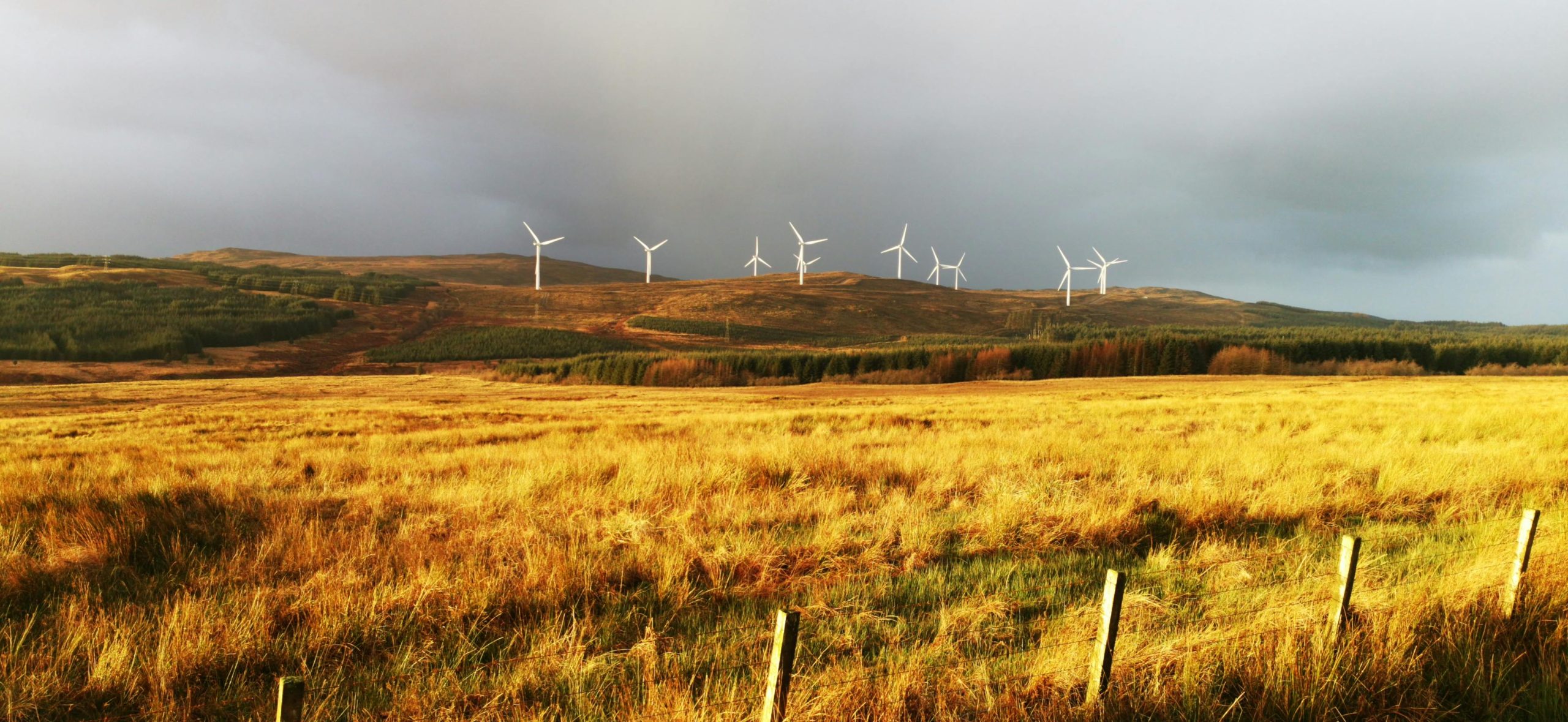The Scottish Government is currently facilitating a consultation on Community Benefits for Renewable Energy Developments.
Anyone can respond here, by 11th April 2025.
The East Lothian Climate Hub provided the below response, and we are providing it to our community in case it may be helpful to frame and consider your own response.
The response was submitted by Bobby Pembleton, the Manager of the East Lothian Climate Hub (also serving as the Energy Theme Lead), as part of an ongoing role in supporting climate action, community resilience, and equitable energy transition across East Lothian. The Hub serves the interests of the East Lothian Climate Action Network (ELCAN), which connects nearly 100 community climate action organisations.
Although we regularly engage with a wide range of community stakeholders, this consultation response was developed independently by the Manager of the Hub and does not represent a formal consultation of the full ELCAN membership. Similarly, while a Climate Hub Policy Group has recently been established, it has not yet been involved in shaping this particular response.
This submission draws Bobby’s experience with the community benefits ecosystem, including work on an Energy Design Sprint for group prioritisation with most other Climate Action Hubs, development of a Community Energy and Heat Development Strategy and East Lothian Energy State of the Sector report, as well as guidance from Community Energy Scotland:
Community benefits consultation CES pointers
It is being provided for transparency to our community, and also to help frame any responses that any ELCAN members may want to provide
Section 1
Q1. In the context of offshore wind development, what or who or where do you consider the relevant communities to be?
We support CES’s recommendation that all Scottish communities have a stake in offshore renewables as national resources, with local benefits complemented by a national approach.
All of Scotland is a ‘relevant community,’ and at least some funding should be used strategically on activities that, optimally, both help communities and move towards decarbonisation. A natural port of call would be practical retrofit activities.
A ring marked percentage of funding should go towards geographically relevant communities.
Geographically relevant communities include:
- Residents and workers in communities affected by offshore infrastructure (e.g. cable landfalls, substations, ports, grid connections).
- Communities of interest: e.g. local fishing industries, marine leisure groups, environmental stewards (such as volunteer beach cleaners, coastal rowing clubs, and coastal ecology groups).
- Other people more generally impacted visually and economically by offshore infrastructure.
In East Lothian, communities like Dunbar, Cockenzie & Port Seton, and East Lammermuir may be most directly impacted by offshore developments and associated infrastructure. These communities must be recognised not only geographically, but also in terms of their socio-economic and environmental engagement.
Q2. When defining the relevant communities to receive benefits from offshore wind development, which factors should be considered, and by whom? Are there any factors which are most important, and why?
The process should be community-led and context-sensitive. Developers must work closely with community anchor organisations, local authorities, and development trusts. In East Lothian, this includes groups like Sustaining Dunbar, local Area Partnerships, and the relevant network of networks: East Lothian Climate Action Network (ELCAN). The Climate Action Hub Programme subsidised by Scottish Government has helped establish 24 Climate Action Networks across Scotland. In total the Hubs have over 100 employees across the country and represent over 1000 community climate action organisations, including orgs like community anchor organisations and community councils. This is a valuable network and resource should be provided to increase capacity so that it can and should be utilised to assist with consultations.
This would help ensure that particular attention be paid to communities with low existing capacity, including deprived areas and those with limited civic infrastructure, to ensure equitable participation.
Q3. Who should decide how offshore wind community benefits are used (decision-makers)? Are there any groups, organisations or bodies you feel should have a formal role in this?
Decision-making should rest with the community itself, via constituted and representative organisations (e.g. SCIOs, CICs). East Lothian in particular has ELCAN and the East Lothian Community Benefits charity (formed by the Association of Community Councils) that has already been negotiating with renewable energy companies. ELCAN is working with ELCB to ensure that they have strong governance. Once this has been done, this is the type of organisation that can be supported, expanded, and further resourced to work with communities and decide how funding is distributed.
Q4. What are the best ways to ensure that decision-makers truly reflect and take into account the needs and wishes of communities when determining how community benefits are used?
There should be no distinction between decision-makers and the community. Democratic, local governance structures with transparent, regular reviews are key. Decisions should align with local place plans, area partnership plans, and emerging climate strategies.
Many communities in areas of deprivation have not had time to develop such plans. Resources must be provided to help these communities to do so, IF it turns out that these plans are to actually be used and working on them would not be a waste of time, so that there is equity in the planning process and the strategies and activities that result from them.
We also support periodic community-led audits and mandatory reporting to ensure accountability and learning.
Q5. What could be done to help maximise the impact of community benefits from offshore wind? What does good look like?
- Make community benefits mandatory.
- Create and fund regional Community Benefit Champion posts, and/or empower existing infrastructures like Climate Action Networks and/or e.g. East Lothian Community Benefits, with expertise in community engagement, facilitation, climate strategy, and governance.
- Provide support for community wealth-building initiatives and revenue-generating assets.
- Offer early-stage funding for capacity building and governance development.
- Prioritise equitable access for communities with low existing capacity, particularly rural, coastal and deprived areas.
Q6: How do you think directing community benefits towards larger scale, longer term, or more complex projects would affect the potential impact of community benefits from offshore wind?
Local communities should retain full control over the use of benefits. That said, enabling larger or longer-term investments—such as energy efficiency retrofits, sustainable transport initiatives, or local skills and enterprise development—can result in transformational change. In East Lothian, there is a need for practical retrofit activity and a lack of the skills, or the motivation of those with the skills to do so.
We need a National Retrofit Strategy and Plan, and for each of the Climate Hubs to help communities, organisations, suppliers, and individuals to move towards this. Where better for the funding to come from than from renewable energy, thus reducing the demand for the energy produced locally and potentially allowing more export? This could be administered and/or facilitated by the Scottish Community Wealth Fund.
There must be flexibility to also invest in relevant short-term or smaller-scale projects, especially in the early years or where community infrastructure is still developing.
Q7: To what extent do you agree or disagree that a regional and/or national approach to delivering community benefits would be an appropriate way to address geographical dispersal of development and multiple communities?
We agree that a national approach is appropriate and necessary, provided that it complements (rather than replaces) local community benefit arrangements. A Scottish Community Wealth Fund looks like a reasonable option to support equity of access and community capacity building across Scotland—including areas, like inland East Lothian, that may not be directly impacted by offshore wind but still play a role in grid infrastructure or transmission. Any national or regional model must be designed collaboratively with communities
Q8: Are you aware of any likely positive or negative impacts of the Good Practice Principles on any protected characteristics or on any other specific groups in Scotland, particularly: businesses; rural and island communities; or people on low-incomes or living in deprived areas?
Positive impacts could include increased investment in local economies, support for skills and employment in deprived or remote communities, and more responsive governance if community-led structures are supported. Care must be taken to ensure that those with limited capacity—particularly low-income, disabled, or digitally excluded groups—are not left behind in participatory processes or application-based funding models. Dedicated facilitation, training, and funded participation can mitigate these risks. Paid roles could take on a pro-active approach to ensure equitable access to communities.
Q9: In your view, what would just and proportionate community benefits from offshore wind developments look like in practice?
A fair approach would involve:
- At least 1% of gross project revenue provided as direct local community benefit.
- A guaranteed minimum of £2,500 per MW per year (index-linked).
- 4% of gross project revenue directed to a national Community Wealth Fund.
- Clear opportunities for shared ownership, providing proactive support for communities to access opportunities, and/or revenue-sharing models, without replacing community benefit payments.
These measures would provide flexibility for communities to meet local needs while securing broader equity across Scotland.
Q10: What processes and guidance would assist communities and offshore wind developers in agreeing appropriate community benefits packages?
- Clear, early-stage guidance on identifying relevant communities.
- Model processes and timelines for engagement.
- Government-funded community benefit champions.
- Access to facilitation, legal, and financial expertise.
- Case studies and good practice repositories.
- A public register of projects and contact points for liaison.
Q11: What do you see as the potential of shared ownership opportunities for communities from offshore wind developments?
Shared ownership can deliver long-term, meaningful control and income for communities. Models such as joint ventures, co-operatives, or community shares in turbines offer pathways for democratic involvement. Shared ownership should be seen as a complement to—not a substitute for—community benefit payments, and it must be structured to include all residents, not just private investors. Given the scale and cost of offshore renewables, significant support must be made to communities to ensure equitable access, especially in the context of having to negotiate with strong organisations with significant legal teams.
Q12: Thinking about the potential barriers to shared ownership of offshore wind projects, what support could be offered to communities and developers to create opportunities and potential models, and for communities to take up those opportunities?
Barriers include high capital costs, lack of legal/financial expertise, and unequal negotiating positions. Support should include:
- Government-backed loan guarantees or investment funds.
- Legal and financial templates and toolkits.
- Free or subsidised advice and training.
- Visibility of opportunities via national mapping portals.
- Conditionality on planning consents or leasing that promotes shared ownership.
- National awareness-raising campaigns and examples of successful practice.
Offshore wind represents a generational opportunity to redistribute wealth, build resilient local economies, and deepen public participation in the energy transition. Shared ownership, if supported properly, is a key lever to unlock this potential.
Section 2
Q1a: Which of the following onshore technologies should be in scope for the Good Practice Principles?
We believe the following technologies should be in scope:
- Wind
- Solar
- Hydro power (including pumped hydro storage)
- Hydrogen
- Battery storage
- Heat networks
- Bioenergy
- Carbon Capture, Utilisation and Storage (CCUS)
- Negative Emissions Technologies (NETs)
- Other: All forms of energy storage.
Q1b: Please explain your reasons for the technologies you have selected or not selected and provide evidence where available.
All new or expanding private energy developments have a role to play in funding a just transition for Scottish communities. While some of the technologies listed are either unproven at scale or not the most efficient forms of decarbonisation in many cases, we recognise that if they are to proceed, they must contribute fairly to community benefit mechanisms.
Including them in scope does not necessarily imply endorsement of those technologies and should not be construed as such, but ensures that communities impacted by their infrastructure are not excluded from benefits.
As I understand, electricity transmission infrastructure is covered under UK-wide policy, so should be formally considered out of scope. However, we encourage the Scottish Government to recommend stronger enforcement of UK guidance, as communities across East Lothian and Scotland are already being affected by transmission-related impacts.
Q2: Should the same Good Practice Principles apply in a standard way across all the technologies selected, or should the Good Practice Principles be different for different technologies? Please explain the reasons for your answer and provide evidence where available.
Wherever possible, Good Practice Principles should be applied in a standardised way across all technologies to support simplicity, fairness, and transparency in developer-community relationships.
However, the level of community benefit—particularly benchmark contributions—should vary depending on the technology, due to differing revenue models and local impacts. For example:
- Onshore wind should retain a higher guaranteed floor (e.g. £7,500/MW/year).
- Solar might warrant a lower floor, as 4% of gross revenue would often be less than this.
- Storage projects require alternative methods of calculating benefit floors.
The method for determining relevant communities and engagement timelines may also differ by technology depending on the type of infrastructure and its potential social/environmental impacts.
That said, the core principles—early engagement, community-led governance, proportional funding, and transparency—should be non-negotiable and universally applied.
Section 2: Improving the Good Practice Principles
Q3: Do improvements need to be made to how eligible communities are identified?
Yes. While there are good examples of local benefit schemes, improvements must be made in how developers engage and identify communities. Engagement must start early and be co-designed with local entities such as community anchor organisations. Please note that I use the SCVO definition of community anchor organisations, e.g. a Development Trust or ‘Sustaining Dunbar’ like organisation.
We support the principle that local, regional, and national levels should all be eligible in appropriate ways.
It is crucial to distinguish between geographically affected communities and communities of interest. Contributions to a national fund (such as the proposed Scottish Community Wealth Fund) must be additional to, not in place of, local contributions.
Particularities in how communities are directly affected should be investigated carefully. For example, communities such as those in inland East Lothian may be affected by grid connections or supply chain infrastructure despite being geographically distant from turbines. These connections should be recognised and included.
Q4: Should more direction be provided on how and when to engage communities in community benefit opportunities, and when arrangements should take effect?
Yes. Engagement should begin before planning or consenting processes. Developers must use varied methods (in-person, digital, through trusted intermediaries like community anchor organisations) and proactively reach out to communities. Specific funding should be made available to, for example, Climate Hubs to reach out via their Climate Action Networks and identify community anchor organisations like local Development Trusts to support this engagement work.
We support a framework in which arrangements take effect prior to or in tandem with development approvals—not only after infrastructure is commissioned—allowing communities to benefit from early investments.
Q5: How could the Good Practice Principles help ensure that community benefit schemes are governed well?
For distribution of affected community level benefits:
Governance must be community-led, with local decision-making bodies that are democratically constituted and transparent. There should be:
- Clear eligibility criteria for decision-making organisations (e.g. SCIOs, CICs), and that they have established or would be in a position via community engagement to establish a remit from the community. The Climate Hub network is suitable.
- Transparent financial reporting and governance reviews
- Representation from across the community and/or area partnerships
- Support for regional coordination where appropriate (e.g. the East Lothian Community Benefits charity in partnership with East Lothian Climate Hub / ELCAN)
Government should also support communities with training, mentoring, and access to professional services (legal, accountancy) to improve fund governance.
For the Community Wealth Fund / national level community benefit schemes proposed, similar conditions should be met.
Q6: How could the Good Practice Principles better ensure that community benefits are used in ways that meet the needs and wishes of the community?
Spending should be aligned with Local Place Plans, Community Action Plans, or Area Partnership priorities where they already exist. A process should be initiated to ensure that equitable access to whatever relevant planning process is chosen is enabled and extended to communities that have not yet been able to engage with it (often due to uncertainty about the influence of the plans and or lack of resource in the community), and/or updated in instances where a community didn’t include things relevant to spending community benefits money (e.g. due to a lack of knowledge that it would become relevant in the future)
Flexibility must remain for emerging needs. For areas without such plans, the support provided must be well facilitated, useful, not become a tick-box exercise.
The Principles should also:
- Promote participatory budgeting and community consultations
- Emphasise long-term community wealth building
- Prevent the use of community benefit funds for statutory services
Q7: What should the Good Practice Principles include on community benefit arrangements when the status of a new or operational energy project changes?
When a project is repowered, sold, or extended, community benefit agreements should be reviewed and updated. Communities should be re-engaged with as early as possible. They must be proactively made aware of these opportunities, and what their involvement in taking on shared ownership could mean to their community, by an independent and supportive body that is looking out primarily for the success of communities. Any revised agreement should reflect the current best practice benchmarks.
Q8: Should the Good Practice Principles provide direction on coordinating community benefit arrangements from multiple developments in the same or overlapping geographic area?
Yes. This is especially important in areas where multiple wind, solar or battery developments may affect the same community. Guidance should encourage pooling of funds if the community wishes to do so.
East Lothian’s model—with the East Lothian Community Benefits Company as a county-wide vehicle for strategic fund coordination—is a useful example. Case studies from Ayrshire’s 9CC group and others could also be referenced.
Q9: What improvements could be made to how the delivery and outcomes of community benefit arrangements are measured and reported?
We support mandatory reporting to a national register such as Scotland’s Community Benefits and Shared Ownership Register. Improvements could include:
- A map showing payments per capita by area
- Date-stamped updates to show currency of data
- Links to associated local plans or strategies, noting gaps and plans to address them
- Clear distinction between financial and in-kind benefits
This would improve transparency and inform future policy decisions.
Q10: In addition to the Good Practice Principles, what further support could be provided to communities and onshore developers to get the most from community benefits?
Capacity-building support is critical. Communities need:
- Early-stage development funding
- Paid participation for residents or staff in under-resourced areas
- Training in governance, planning, and fund management
- Access to legal and technical advice
Developers also need clearer guidance, case studies, and an independent body (e.g. a Community Benefit Champion) to help mediate and support good practice from the outset.
Q11: Do you think that the Good Practice Principles should continue to recommend a benchmark value for community benefit funding?
Yes.
Q12a: Should the benchmark value be the same or different for different onshore technologies?
The benchmark value should be different for different technologies, based on revenue potential, local impact, and operational scale. A single figure does not reflect the varying economics of solar, wind, hydro, and battery storage.
For example:
- Onshore wind remains the most impactful and profitable, and a higher benchmark (£7,500/MW/year) is appropriate.
- Solar typically generates lower revenue per MW, and a lower benchmark should reflect that.
- Storage and others require bespoke metrics that reflect their atypical operating profiles.
Q12b: How could we ensure a benchmark value was fair and proportionate for different technologies?
The most fair and transparent approach is to:
- Benchmark based on percentage of gross annual revenue (e.g. 4%)
- Include a guaranteed floor to ensure communities always receive a baseline level of benefit
This combined model allows higher payments in high-revenue years while protecting communities in leaner periods. It creates fairness for both developers and communities. Index-linking the floor ensures that its value is not eroded over time. This dual approach also supports more equitable long-term planning and builds trust across the sector.
Q13: Are you aware of any likely positive or negative impacts of the Good Practice Principles on any protected characteristics or on any specific groups in Scotland, particularly: businesses; rural and island communities; or people on low-incomes or living in deprived areas?
Yes, we are aware of both positive opportunities and potential risks if the Good Practice Principles are not implemented with care.
Positive impacts:
- Rural and island communities, which often host renewable energy developments, may benefit from targeted investment in infrastructure, jobs, training, and transport.
- Low-income communities, especially coastal and agricultural, can gain new resources for climate adaptation.
- All communities could benefit from a National Retrofit Strategy and Plan, and/or practical retrofit which would include ensuring warm homes, skills development, and all could benefit from increased local resilience.
Risks to mitigate:
- Communities with lower organisational capacity may struggle to access or manage benefits equitably. This could worsen inequality.
- People with disabilities, language barriers, or low digital access may be excluded from participatory processes without inclusive design.
- Women, ethnic minorities, and young people are often underrepresented in local governance structures; engagement strategies should actively counteract this.
Recommendations:
- Dedicated funding for under-resourced and marginalised communities
- Use of trusted intermediaries (e.g. Climate Action Hubs) to support engagement
- Inclusive and diverse community governance practices
- Equalities impact assessments built into benefit fund planning
These steps would help ensure that the Principles actively promote equality and deliver a fairer energy transition.




